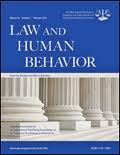 While illness-based motivational influences appear to be the primary influence for violence in persons with MMI, non-illness based motivations require consideration in legal and clinical decision-making. This is the bottom line of a recently published article in Law and Human Behavior. Below is a summary of the research and findings as well as a translation of this research into practice.
While illness-based motivational influences appear to be the primary influence for violence in persons with MMI, non-illness based motivations require consideration in legal and clinical decision-making. This is the bottom line of a recently published article in Law and Human Behavior. Below is a summary of the research and findings as well as a translation of this research into practice.

Featured Article | Law and Human Behavior | 2016, Vol. 40, No. 1, 42-49
Assessing Illness- and Non-Illness-Based Motivations for Violent Persons with Major Mental Illness
Authors
Stephanie R. Penney, Centre for Addiction and Mental Health, Toronto, Ontario, Canada, and the University of Toronto
Andrew Morgan, Ontario Shores Centre for Mental Health Sciences, Whitby, Ontario, and the University of Toronto
Alexander I.F. Simpson, Centre for Addiction and Mental Health, Toronto, Ontario, Canada, and the University of Toronto
Abstract
Research on violence perpetrated by individuals with major mental illness (MMI) typically focuses on the presence of specific psychotic symptoms near the time of the violent act. This approach does not distinguish whether symptoms actually motivate the violence or were merely present at the material time. It also does not consider the possibility that non–illness-related factors (e.g., anger, substance use), or multiple motivations, may have been operative in driving violence. The failure to make these distinctions clouds our ability to understand the origins of violence in people with MMI, to accurately assess risk and criminal responsibility, and to appropriately target interventions to reduce and manage risk. This study describes the development of a new coding instrument designed to assess motivations for violence and offending among individuals with MMI, and reports on the scheme’s interrater reliability. Using 72 psychiatric reports which had been submitted to the court to assist in determining criminal responsibility, we found that independent raters were able to assess different motivational influences for violence with a satisfactory degree of consistency. More than three-quarters (79.2%) of the sample were judged to have committed an act of violence as a primary result of illness, whereas 20.8% were deemed to have offended as a result of illness in conjunction with other non–illness-based motivating influences. Current findings have relevance for clarifying the rate of illness-driven violence among psychiatric patients, as well as legal and clinical issues related to violence risk and criminal responsibility more broadly
Keywords
interrater reliability, major mental illness, motivation, violence
Summary of the Research
“Epidemiological and meta-analytic studies have demonstrated that persons with major mental illness (MMI) are at elevated risk for engaging in violence toward others when compared with the general population. Simply documenting a relationship between MMI and violence, however, does not explicate the underlying mechanisms that are responsible for this association. Several hypotheses have been proposed to explain the link, including the effects of organized delusions in driving violent behaviors, as well as the disorganizing and disinhibiting effects of psychosis on behavior” (p.42).
“The notion that psychiatric symptoms exert a causal effect on behavior aligns with the popular belief that most instances of violence among individuals with MMI are symptom-driven. Despite the pervasiveness of this notion, there is little empirical evidence to support it. In fact, research suggests that the strongest risk factors for violence and criminality are shared by offenders with and without MMI, and that even individuals adjudicated as not criminally responsible (e.g., Not Criminally Responsible on account of Mental Disorder [NCRMD] in Canada) may commit an array of “sane” and “insane” offenses over time. Furthermore, other established risk factors for violence, such as neurocognitive impairments, early behavioral problems, substance misuse, and antisocial personality traits are found to be more common in people with schizophrenia, and may partly explain the increased prevalence of violence in MMI. Persons with MMI are also found to have greater levels of social and economic related risk factors for offending, such as living in impoverished neighborhoods and having lower levels of personal support. Therefore, among the population of individuals with MMI who offend, heterogeneity in contributing risk factors and motivations for violence beyond the effects of illness appears likely” (p. 42).
“Motivation is commonly defined as a process that initiates, guides, or maintains goal-oriented behaviors… as referenced above, several studies have investigated the co-occurrence of MMI and violence, whereas fewer have identified the motivational influences or causal processes that may link MMI to these behaviors. This is a significant gap in knowledge, given the centrality of the concept of motivation in both law and current advances in violence risk assessment” (p.43). “Admittedly, motives are ‘elusive, subjective, and often difficult to define,’ leading some scholars to describe conclusions about motivations for crime, such as those underpinning criminal responsibility evaluations, as little more than informed speculation. Further, most behavior is multidetermined and can be influenced by both illness- and non–illness- motives. This has impacted the reliability with which researchers have been able to measure motivational influences, and has also likely contributed to the variability in estimates of MMI-driven violence” (p.43).
“The proportion of individuals with MMI who are judged to have acted violently as a direct result of illness varies across studies, likely because of variations in sample type (e.g., psychiatric, correctional), in the quantification of symptoms and violence, and in how motivational factors are elicited and rated” (p. 44). “The current study introduces a coding scheme for the assessment of illness- and non–illness-based motivations for violence and offending in a MMI sample, and reports on the scheme’s interrater reliability. Additionally, we present data on the proportion of offenses motivated by illness-based factors, as well as the frequency of non–illness-based motivations in our sample. Lastly, we examine whether there is a relationship between different types of motivation and the level of severity/potential for harm represented by the offending behavior” (p.44).
“We reviewed 72 psychiatric reports which had been submitted to the court to assist in determining criminal responsibility, as well as the supplementary record of arrest” (p.44). The reports described patients who were undergoing psychiatric assessment at a psychiatric hospital in Canada. “We developed a coding instrument to record the presence/ absence of specific psychiatric symptoms (i.e., hallucinations, delusions, thought/behavioral disorganization, depressed or elevated/ expansive mood) at the time of the index offense, and the degree to which each of these variables was judged to have directly motivated the offending behavior in question…we distinguished the presence of symptoms from their motivational impact, to accurately capture those instances where symptoms are present but not motivating the behavior in question” (p. 45). “Two raters with experience in forensic psychology/ psychiatry independently coded each report. After an initial batch of reports had been coded, the raters met to discuss their ratings and resolve any discrepancies that arose. The remaining reports that are the subject of the reliability analyses presented here were then coded” (p.45).
“Results from the current study, taken from a sample of individuals undergoing an assessment of criminal responsibility, align most closely with [previous] research in a high security hospital setting, and suggest that approximately three-quarters of individuals offended as a primary result of illness, and that symptoms were of a primarily psychotic nature. It is reasonable to expect that the rate of psychotic motivation in samples such as these would be higher as compared to justice-involved samples” (p.47).
“The primary motivation variable also allowed us to determine the proportion of individuals who were judged to have offended primarily as a result of illness, as opposed to primarily as a result of non–illness-based factors. We found that the majority of the sample were judged to have offended as a primary result of positive symptoms of psychosis, with fewer judged to have offended as a result of thought or behavioral disorganization linked to MMI or as a primary result of mood symptoms” (p.46).
“Importantly, the current estimate of illness-based motivation was generated from a structured coding scheme that appears to possess satisfactory interrater reliability. Results from this study suggest that the presence of specific psychiatric symptoms, as well as problems related to substance use near the time of a patient’s index offense, were reliably coded based on comprehensive psychiatric reports for the courts, detailed arrest information, and collateral sources” (p.47). “Judgments regarding the degree to which certain symptoms of MMI motivated the offending behaviors in question also demonstrated good consistency across raters. Similar to the pattern of results obtained for the presence/absence judgments, judgments regarding the likelihood of offenses being motivated by more obvious symptoms of psychosis (e.g., a command hallucination, delusions) achieved higher reliability as compared with judgments reflecting the motivational influences of relatively more ambiguous symptoms (e.g., behavioral disorganization)”(p.47).
“The reliability estimates obtained in the current study are comparable with those reported by [previous research] pertaining to estimates of delusional motivation, as well as for estimates of the direct effects of MMI and substance use on offending. In contrast, the level of agreement reflecting primary motivation achieved here was higher than the estimate in [a previous] study classifying offenders into broad motivational categories based on their lifetime pattern of offending…Although the number of cases rated for reliability purposes was significantly higher in this study, our reliance on two raters has implications for the generalizability of results presented here” (pp. 47-48).
Translating Research into Practice
“The study of motivational influences among those with MMI who have offended can inform the clinically and legally relevant question of whether specific symptoms of MMI have directly motivated an act of violence or offending for a given individual, and if so, the relative degree of influence they exerted as compared with non–illness-based factors” (p. 46).
“Unlike positive symptoms of psychosis, certain mood-based symptoms appear to share a higher degree of conceptual overlap with conventional motivations such as anger and irritability, or grandiosity and risk-taking behavior. Further study of the reliability of motivational influences for offending is thus needed, particularly in diagnostically heterogeneous samples” (p.47).
“When we collapsed our motivational subtypes to more broadly reflect symptom-based versus conventional motives, raters demonstrated a high level of agreement with respect to the primary motivation judged to be operative at the time of the index offense. This type of broad distinction is arguably most relevant from a psycholegal perspective, where binary decisions must often be made (e.g., in regards to an individual’s criminal responsibility)” (p.47).
“We did not find evidence to support the idea that different types of primary motivation were associated with more versus less severe offending behavior. However, primary mood and conventional motives were infrequent; it is possible that in a larger sample we may see significant effects, for example, whereby offenses driven by mood symptoms possess significantly higher potential for harm as compared with conventional motives. This is an important avenue to pursue, as findings could have direct implications for the assessment of violence risk, and in particular, risk for imminent or serious forms of violence” (p.48).
“The current study is a preliminary effort to develop a reliable method for indicating the extent to which different symptoms of MMI motivate violent and offending behavior, and disentangle symptom-based offending from violent and antisocial behaviors that may have other motives. This type of research can help to clarify legal and clinical issues related to violence risk and criminal responsibility, in part by better defining the nature and origins of each person’s offending and corresponding treatment needs. A reliable approach to assessing motivation can also enhance clinical understanding and improve the consistency of clinical formulations regarding violence risk and criminal responsibility, including individualized risk management plans that incorporate hypotheses about motivation: that is, how specific symptoms or risk factors caused or contributed to a person’s previous offending, and how they may influence a person’s decision to offend in the future” (p. 48).
Other Interesting Tidbits for Researchers and Clinicians
“It is important to note that psychiatric assessments of criminal responsibility in Canada do not require the assessor to address motivation, or to tackle the task of proving that the offending behavior in question was caused by symptoms of MMI directly. Rather, symptoms of the MMI must typically be shown to have incapacitated the individual with respect to the relevant competencies of appreciating the consequences of his or her actions and/or knowing their wrongfulness” (p. 48).
Join the Discussion
As always, please join the discussion below if you have thoughts or comments to add!







